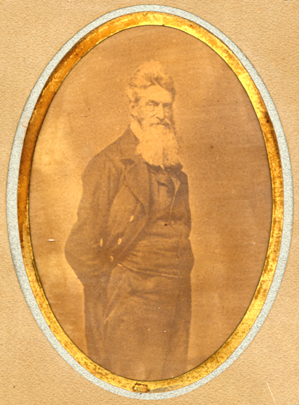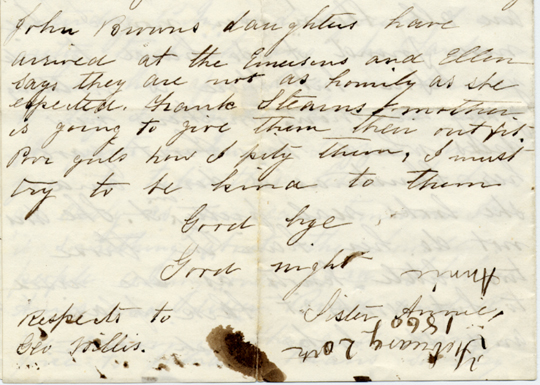43 (above) and 44 (below)
 
|
JOHN BROWN IN CONCORD
43. John Brown, bearded, as he appeared in 1859 on his second visit to Concord. Photograph, matted and framed. Presented by John Marrs, 1923. 44. Annie Keyes Bartlett. Autograph letter to Edward
Jarvis Bartlett, February 20, 1860. From a collection of twenty-four
letters from Annie Keyes Bartlett to Edward Jarvis Bartlett, 1860-1865.
Displayed letter presented by Dr. William Bartlett.
During the 1850s, Kansas was a hotbed of conflict. The Kansas-Nebraska Act of 1854 left the question of whether or not slavery would be allowed in Kansas to be decided by settlers of the territory, abrogating the Missouri Compromise of 1820. For a time, Kansas had two governments, one that permitted and one that outlawed slavery. As abolitionist and proslavery settlers clashed, lives and property were lost. In 1855, militant abolitionist John Brown went to Kansas and threw himself into keeping Kansas free by any available means, armed violence included. Emerson supported the cause of a free Kansas. He attended meetings in Concord and elsewhere to aid antislavery settlers, and spoke in Cambridge at a Kansas relief meeting in Cambridge on September 10, 1856. In 1857 and 1859, when John Brown came to Concord, Emerson welcomed him into his home. Frank Sanborn, who ran a progressive coeducational school on Sudbury Road, was deeply involved in raising money for Kansas relief and for Brown’s forces. Brown came to Concord because of Sanborn. When Brown spoke in Concord’s Town Hall in March of 1857, Emerson was impressed by his fierce commitment to his righteous cause. In May of 1859, planning an armed slave uprising, Brown returned to Concord and spoke again at the Town Hall. Five months later, he led an ill-fated raid on the federal arsenal at Harpers Ferry, West Virginia. He was tried, found guilty, and executed on December 2nd. Thoreau, Alcott, and Emerson—all of whom had been in Brown’s audience in May—participated in the service held in Concord on the day of his execution. After Brown’s arrest, Emerson spoke at meetings to raise money for his destitute family. After his execution, both Emerson and—even more vigorously—Thoreau promoted the image of John Brown as a saint and a martyr rather than the fanatic that many felt he had been. In February of 1860, Frank Sanborn arranged to bring Anne and Sarah Brown, two of John Brown’s children, to Concord to attend his school. When they arrived here, the Brown girls stayed with the Emersons. In the February 20, 1860 letter shown here, Annie Keyes Bartlett writes her brother Edward Jarvis Bartlett (“Ned”) of their arrival at the Emerson house. Annie and Ned were two of the nine children of Dr. Josiah Bartlett, who practiced medicine in Concord for fifty-seven years.
No image in this online display may be reproduced in any form, including electronic, without permission from the Curator of Special Collections of the Concord Free Public Library.
Next Entry - Previous Entry - Back to Section V Contents Listing - Back to Exhibition Introduction - Back to Exhibition Table of Contents |